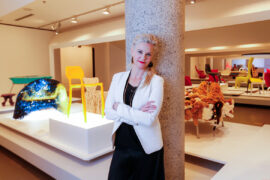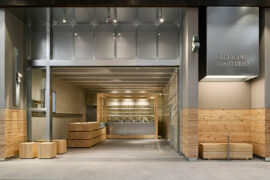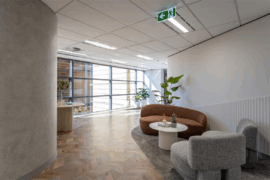Wood Marsh’s 40-year legacy shines through landmark infrastructure projects. Recently completing stunning stations at Coburg and Moreland, their designs blend modernity with community needs.

April 16th, 2024
Wood Marsh, a practice that spans 40 years, has been the first to design many of Melbourne’s landmark infrastructure projects – including the monumental noise walls along the Eastern Freeway (the first non-building to receive the Victorian Architecture Medal), Eastlink, the Geelong bypass and the pedestrian bridge at the west end of Bourke Street. The Australian Centre for Contemporary Art (ACCA) was its first gallery, and these recently completed railway stations, one at Coburg and the other two kilometres away at Moreland, also represent an important milestone for Wood Marsh.
Commissioned by the state government and the Level Crossing Removal Project, Wood Marsh has completed 11 of the intended 100 across Melbourne. “In the Victorian period, you would have seen a person flagging a lantern when they needed to cross a major thoroughfare. But these stations are designed for the 21st century, allowing for safety and creating an opportunity to use the space below for pedestrians, cyclists and the local community,” says architect Roger Wood.

The local community was one of the factors considered when the design for the Coburg station was conceived. Featuring textured concrete panels whose geometry and repetition evoke a slightly Moorish feel, Wood explains that “we looked at the statistics, with a significant proportion of the local community being Islamic.” Indeed, it was reassuring for his team to hear a comment from one passenger on social media: “The dimpled pattern reminded me of the pattern on my grandmother’s window shutters in her home in Morocco.”
Wood Marsh was also inspired by many of the Victorian brick stations, including Flinders Street Station with its ornate cornices and pediments. “There’s also a nod to the arched entrance of the National Gallery of Victoria,” says Wood, pointing out sculptural qualities of these stations, illuminated in part by LED lights. Now commuters enter through an arched faced to an impressive lobby that takes one over the railway tracks – the result not only creates a sense of identity for the local communities but, just as importantly, frees up the adjacent land – with everything from a cycling track and landscaped gardens, designed by Tract. There’s now a buzz at peak hour that removes the danger of passengers getting hurt by passing traffic or by trains.
Related: The Powerhouse collection storehouse is an artwork in itself

Moreland, the smaller of the two stations, is as heroic as a piece of public infrastructure. Framed in mesh and featuring a terracotta brick base that acknowledges the detached homes nearby, it creates a destination point as much as alleviating the danger that comes with people and traffic intersecting. “It’s about looking at infrastructure, such as stations, with fresh eyes, rather than simply replicating what may already have been done,” says Wood.
While Wood Marsh has made its indelible mark on Melbourne through its infrastructure projects it was, in this instance, as mindful of respecting the past – restoring the simple brick buildings that formed part of the station. The corrugated roofs, for example, added in the 1960s, now appropriately feature slate, the same type that was imported from England. These buildings were obviously of their time, but the new stations point well into the future, elevating stations that were once prosaic buildings to strong architectural forms – light-filled and engaging, and, critically, places that are enjoyable to use. With the elevation of these stations, new outdoor space has been created, space to the tune of three times the size of the Melbourne Cricket Ground (MCG) – giving back valuable outdoor spaces to communities in the process.
Wood Marsh can be contacted on 03 9676 2600.






Next up: AIR by OMA is a multifaceted adaptive reuse project in Singapore
INDESIGN is on instagram
Follow @indesignlive
A searchable and comprehensive guide for specifying leading products and their suppliers
Keep up to date with the latest and greatest from our industry BFF's!

Sydney’s newest design concept store, HOW WE LIVE, explores the overlap between home and workplace – with a Surry Hills pop-up from Friday 28th November.

For a closer look behind the creative process, watch this video interview with Sebastian Nash, where he explores the making of King Living’s textile range – from fibre choices to design intent.

Designed by artist Abdul Abdullah, the porcelain façade for this Melbourne train station has been executed with custom-printed Fiandre DYS panels.

The Northern Concourse at Sydney’s Central Station, a significant infrastructure project in the context of the city’s evolving transport system, has recently been completed by Woods Bagot in collaboration with John McAslan + Partners.
The internet never sleeps! Here's the stuff you might have missed

In what the DIA describes as a “major boost for the profession,” a NSW Parliamentary Commission has released a report on the Review of the Design and Building Practitioners Act 2020.

Hecker Guthrie brings a natural, material-led design to Green Cup’s new Chadstone store, pairing pine, steel and glass with a grab-and-go layout inspired by the brand’s fresh, organic ethos.

A thoughtful, low-waste redesign by PMG Group in collaboration with Goodman has transformed a dated office into a calm, contemporary workspace featuring a coastal-inspired palette and Milliken flooring for a refined finish.